Ferrari F355 SPIDER UNIQUE CLASSIC COLOR 355 SERVICED HRE MANUAL GEARBOX
1996 Ferrari 355
Ferrari 355 1996 technical specifications | |
|---|---|
| Condition: | Used |
| Item location: | Beverly Hills, California, United States |
| Make: | Ferrari |
| Model: | 355 |
| SubModel: | SPIDER |
| Type: | Convertible |
| Year: | 1996 |
| Mileage: | 17,800 |
| VIN: | ZFFXR48AXT0105109 |
| Color: | LE MANS BLUE |
| Engine size: | V8 |
| Number of cylinders: | 8 |
| Power options: | Air Conditioning, Power Locks, Power Windows, Power Seats |
| Transmission: | Manual |
| Interior color: | RED BORDEAUX |
| Safety options: | Anti-Lock Brakes, Driver Airbag, Passenger Airbag |
| Options: | 4-Wheel Drive, CD Player, Convertible, Leather Seats |
| Vehicle Title: | Clear |
| You are interested? | Contact the seller! |
Description |
|---|
ZFFXR48AXT0105109
Detailed history for this Ferrari outlined below.
This is perhaps the rarest and most striking of all F355 Ferrari Spiders.
While there are literally thousands of red, yellow and black 355s this is the only classic Le Mans blue over Bordeaux 355 Spider known to exist.
This is a classic color combination that was popular on classic Ferrari, Lamborghini and Maserati from the golden era of motoring and remains so, such so that when Ferrari unveiled its hyper rare F60, of which only 10 of the $2.5 million dollar cars were ever built, it was a blue car with a red interior…much like the 1950s California Spider with the same color combination.
When Ferrari/Maserati designer Jason Castriota, who designed the 599, Maserati Birdcage 75th and the Maserati GranTurismo, decided to build a million dollar one-off 599 for his father he too chose blue over red for his personal creation.
This Ferrari features the very expensive ($10,000 I’m told) option of the upper dash and steering wheel in red leather along with dark navy blue carpets that contrast beautifully yet subtlety with the red interior and complement the matching blue exterior.
The $7,000 HRE wheels really compliment this Ferrari’s color combination while giving much better grip and braking thanks to the larger front and rear high performance tires.
The typical shrinking leather dash on the F355 was just addressed with thousands spent on new leather. Similarly, the red leather cover for the top is alsonew ($1500). The red leather interior, including the very expensiveOPTIONof a full red leather dash and matching steering wheel (said to be a $10,000 option), is in excellent condition as are the beautifully contrasting navy carpets with matching Ferrari original navy floor mats.
A full engine out service was performed less than 1000 miles ago.
New hood and trunk struts were installed.
There are no sticky parts.
Gorgeous $1,000 carbon fiber door sill trim panels have been fitted.
(The blue you see on the left side of the engine panel ismerely a reflection from the bar: The panel is actually black and matches the panel on the right side.)
This Ferrari 355 is in exceptional show condition.
The 355 is appreciating and on its way to collector car status. ROAD & TRACK listed it as one of the 10 best looking mid-engined Ferraris of all time, saying it sounds “incredible” and that its “styling has aged well, perhaps looking better than when it was first introduced.”
The great Phil Hill described it as one of the 10 best Ferraris ever built.
Top Gear’s Jeremy Clarkson said it was “the nicest car I have ever ever driven.” He then said he came back from that drive and decided “I have to have one, I have to have one. I have to.” He then went out and bought one for himself! After buying it he said “it’s still the best car I’ve ever driven.”
Richard Hammond recently described the 355 in glowing terms as well in an article (below), echoing Road and Track’s sentiment, stating: “If anything, the 355 has somehow got more attractive in the 19 years since it arrived.”
A recent 5,600 mile reviewer of the 355 for AutoLog noted: “I’m paraphrasing, but Autoblog reader Paul Dyer asked me one day, ‘Want to drive my 1998 Ferrari F355 Spider from San Jose, California, to me in Newfoundland?’ I'm also paraphrasing and leaving out some colorful but unpublishable language, but essentially I said, "Yes." That's how I ended up on a two-week, 5,600-mile road trip, getting an extensive and intimate look at one of the most spectacular cars of our generation. Here's what I discovered. To paraphrase, you don't even know how badly you want an F355.
The F355 Spider is the last beautiful Ferrari. Subsequent stallions are modern and dramatic, the F355 is eternally gorgeous, like Brunelleschi's doors and sunsets in Viareggio. The Iliad would still make sense if you said the Greeks took to ship after a Trojan keyed Menelaus' F355. You cannot say the same about the 348, or even the 458 (though we do love it so). “Road & Track said the F355 had "probably the best sports-car engine ever made." Jeremy Clarkson said it was the best car he'd ever driven. That owner who said he wouldn't recommend it? He's had two, and still uses one as his daily driver.”
On Pistonheads it was also said the 355 was the last “truly beautiful” Ferrari. In fact, it’s a common notion that the 355 was the last truly classically pretty Ferrari.
The 355 is the last Ferrari built with a throttle cable between the gas pedal and the throttle bodies on the engine and a rod operated manual gearbox. It is the last “small” Ferrari. It is the last traditionally built Ferrari. It is the Ferrari that saved Ferrari and turned its reputation around in the mid-1990s. It is well on its way to being a collector’s Ferrari.See the article belowcomparing the F355 to the Dino.
The 355 is a great investment. It's the end of the Enzo era inspired cars, the last of the hand-built cars and they made very few with just 2,664six speed manual transmission spiders being made for the world. Compare that to the 360 where Ferrari made more than 13,000 of that model approximately half of which are spiders! This is the end of the small, svelte go-kart like handling Ferraris.
It sounds more like an F1 car than any other road Ferrari.
It has 5 valve per cylinder and titanium connecting rods.
It is the last of the Ferrari with a manual transmission and a true throttle cable as opposed to indirect drive by wire found in the 360 and later cars. It is the best shifting, best driving true sports car from Ferrari bridging the analog cars to digital cars threshold.
The 458 spider is an amazing car but it was mass produced, still costs around $250k and only comes with an automatic transmission and drive by wire, doesn't sound as good as the F355, and as a spider doesn't look as good as the F355 with its two giant humps behind the seats.
It’s also huge compared to a 355 and takes no driver skill and has far less driver involvement. If you are wanting a true classic Ferrari experience with modern performance capabilities the F355 is the only car that fits the bill. Fast, fun, lightweight, sounds great, great to look at, and by today’s Ferrari standards produced in limited numbers. More fun and nimble than a 550, the other last analog Ferrari. The F355 will only appreciate as a classic in the future.
HISTORY
This Ferrari currently has a clear title. I have the full history of the car and I have spoken to the prior owner of the vehicle responsible for bringing the car to California. Please read the full history.
Here is the history for this Ferrari: The prior California owner, then an Executive with Warner Brothers, purchased the car from Huntingridge Motors in 2005. One evening he was celebrating the conclusion of a work project at a Hotel on the corner of La Cienega Blvd and Beverly Blvd here in Los Angeles. He let the manager from computer animation company they were working with drive his Ferrari. They sat at a light at that intersection adjacent to the hotel. I have spoken to both the owner and the driver and both state what happened next. Their left turn arrow turned green. She started her left turn and was driving very slowly. The owner told her to give it some gas and she gave it only a slight amount of gas. He then instructed her to give it some more gas. By now they were midway through the turn. She gave it a lot more gas just as the car came into its powerband and the car spun as it was already mid-turn. The car was not going very fast as it she was just turning left at the intersection where the hotel was. With the Ferrari fishtailing, the Ferrari’s rear wheel hit the sidewalk. That was it. They both got out of the car and were actually relieved to see there was no body damage. Even the wheel itself looked okay but clearly the A-arm had bent as a result of hitting the curb. I have obtained the insurance company photographs which confirm this as well. Not one body panel on the car was damaged, no airbags deployed nor was there any serious damage. All the damage was of the simple bolt-off, bolt-on repair variety.
At that time the owner had decided he wanted a BMW Z8. So the Ferrari was taken to Ferrari of Beverly Hills, the most expensive place probably in the nation to service and repair a Ferrari. Just as expected, they wrote a substantial estimate as each brand new part from their retail price sheet was expensive (and typically more expensive than even other Ferrari dealers). They even stated on the estimate that the removable subframe needed to be replaced and at a huge expense. Yet the subframe did not need to be removed or replaced which is readily verifiable. Thus, Ferrari of Beverly Hills did what was expected, they wrote a high estimate. Also as expected, Mercury Insurance concluded it would be more cost effective to pay off the car and then sell the car at an auction. As the car still looked very good without any damaged body panels, a new looking interior and super low miles, Mercury calculated it would generate a good auction sale value.
By paying the car off and then selling it at an auction Mercury could avoid having to pay other non-repair costs, such as rental car and loss of use of the Ferrari. Mercury would have had to have paid for a rental car that was comparable to the Ferrari while the car was being repaired. Whether a loss of use claim or a rental car cost, renting a Ferrari is typically over $1,000 a day and if the car took four weeks to repair which was entirely possible (e.g., waiting for parts from Italy) that cost alone could be in excess of $30,000. As the owner had his eye on a Z8 he was happy to have Mercury “total” his Ferrari. With Mercury thinking they could get $45,000 to $50,000 for the Ferrari at an auction and save $30k in rental and loss of use fees and with the owner having “only” paid approximately $70k for the Ferrari, Mercury made a business decision to cut a check and sell the car at an auction. Mercury turned this paper into California’s DMV who then proceeded to issue a branded California title. A gentleman purchased the Ferrari and had it repaired and titled in his home state of Illinois where a non-branded title was issued.
This Ferrari was not issued a branded title because of extensive damage. On the contrary, it was branded simply because Mercury concluded it would be more cost efficient to sell the car at an auction. I have this information straight from Mercury Insurance records, including numerous photos from Mercury Insurance, and from speaking directly with the owner and the driver of the Ferrari.
Owners Manual and tool kit included.
From CLASSIC DRIVER:
Has the Ferrari F355 already become a classic?
22 August 2014
Inheriting the proportions of its predecessor, the Ferrari F355 was outwardly a much better-resolved proposition, both aesthetically and aerodynamically. But beneath the smoother skin were further major advancements, including power steering, variable damping, and a 100cc engine enlargement to 3.5 litres. In revised form, the now-375bhp V8 revved out to 8,500rpm and, even more impressively, conjured more bhp per litre than the V12 in the McLaren F1.
“It was also the first truly reliable Ferrari,” adds Hartley Junior. “Unlike the Testarossa and 348, you could invariably put one in for a routine service without being hit with an astronomical bill.”As one era was beginning, another was coming to an end: it was to be the last of the breed to be hand-built, with the 360 and later descendants moving to mass production.
“Perhaps this is why it’s similar to the F40 and F50 in the way it follows the trends of the classic car market,” ponders Hartley Junior. “In recent years, values of the 355 have climbed 25-30% – influenced somewhat by the 328 GTS – and I think this will continue to be the case. I can see this particular example being a quarter-of-a-million-pound car within the next 10 years.”
“The 355 was a sweet spot in the transition from ‘analogue’ to ‘digital’, blending timeless looks and an honest character with just enough modern influence to make it a tempting proposition today."
TOP GEAR AND RICHARD HAMMOND ON THE F355
All the legend, the myth, the history and mystery in the world cannot distract from one single fact when it comes to Ferraris: they have to be pretty. Stat sheets can go on about power-to-weight ratios, structural stiffness, torsional rigidity and exotic materials all day long, but if the car looks like a moose, then it’s a moose - an offence made all the worse if it’s supposed to be a prancing horse.
The 348 that preceded the 355 was not an especially ugly car, but it also wasn’t especially pretty. The slats down the side echoed the Testarossa - not a good thing - so it looked dated even when it was brand new. And it certainly wasn’t a hit, performance-wise. In fact, much was made of the news that Honda launched the NSX at the same time, and it appeared to be, in every single way, better than the Ferrari.
The 355 was Ferrari’s answer. Beauty and power came together and are still very much in evidence today. I’m not one for getting all gooey about Ferraris in general, but there is undeniably something that happens deep inside when you see that yellow badge on a V8 or a steering-wheel boss.
Ferrari: the name carries so much weight, even to those who, like me, have never had - nor wanted - a hat with the brand on it. And, my God, the 355 is pretty. It shared almost every dimension with the 348, but the body was all-new and its sculpting had involved a rumoured 1,800 hours of wind-tunnel testing. But there’s little sense of form following function here; it’s too pretty for that. If anything, the 355 has somehow got more attractive in the 19 years since it arrived.
Inside, I get a reminder that all Ferraris go through a phase when they are not classic - they’re just old Fezzers. I’d say that the 355 is coming through that and entering the classic stage of its life. In true Ferrari form, the interior has dated well. The layout, the design and the feel of it all scream of their own time and, while not fooling anyone that they were drawn yesterday, still have something to say about their period in car design… almost the definition of a classic, in fact.
The mid-mounted 380bhp V8 revs to 8,250rpm and sounds satisfyingly guttural and raucous when it does so. It’s a Ferrari, so while it has to be pretty, it can’t afford to be slow either. And it’s quick, it really is. The headlines, 0-62mph in 4.7 seconds and a top speed of 183mph, are both perfectly acceptable, thank you. The way it delivers those is what it’s all about. The bark and fizz of the V8, the click-clack through that iconic, shiny H-gate - it’s all there. It’s a Ferrari and feels it.
The engine and suspension all received major updates to produce the 355, and the gearbox too, with a six-speed manual operated, of course, through that sculptural gear selector. It feels all those things a Ferrari needs to feel; it’s a taut thoroughbred, and you get the sense too that, once you’ve overcome the inevitable nerves that can flutter at any encounter with any Ferrari, the thing is biddable and usable, with perhaps just a touch of fragility to keep things special.
There’s a huge amount of love for the F355, with some claiming it pretty much saved the company from the doldrums in the early Nineties, others that it was the car that finally shifted the old-fashioned and faintly stuffy conviction amongst the Ferraristi that the only ‘proper’ Ferraris were the V12s.
Some, including F1 champion Phil Hill, named it as one of the 10 best Ferraris ever. A landmark car, then, in the story of a legendary carmaker.
COMPARING THE 355 TO THE 246 DINO
The Dino became an instant hit with the new Ferrari customers and it was a brilliant piece of automotive design and engineering. It also moved Ferrari up a number of gears
It used to be that a gentleman driver would only consider a Ferrari with a large and powerful V12 engine mounted up front. Porsche manufactured small, rear-engined sporting cars for the arriviste. All that changed when Ferrari launched the Dino, with a mid-mounted V6, and followed it with a succession of V8-engined sports cars. Ever since, Ferrari has offered two tiers of performance and style – but the Dino has moved out of the new-money realm into the collector-car stratosphere. Could the 1990s F355 be about to follow suit?
Ferrari broke from its traditional front-engine philosophy in 1968, when the diminutive Dino appeared. The new model was not even badged a Ferrari; it was simply a Dino 206GT. To make matters worse it was developed along with Fiat, the V6 finding its way under the bonnet of the Fiat Dino Coupé and Spider. Motoring aristocrats such as the Agnellis of this world were about to be joined by successful Luigis who owned lucrative pasta joints. What was Enzo thinking?
To be fair, the Old Man wasn’t keen on the mid-engine configuration for road cars – although his 250LM racer had proved to be the future for sports racing cars – as he thought the layout unsafe in the hands of customers. In the 1950s, his son Alfredo Dino Ferrari had been working with legendary engineer Vittorio Jano on small-displacement V6 racing engines that translated into successful racing cars, but Dino died of muscular dystrophy and never saw his ideas realized with the very successful road-going Dino.
As was often the case with Ferrari (and other small manufacturers), building the required production run of 500 vehicles to meet the homologation rules was problematic so, for the new 1.6-litre Formula 2 series in 1967, Ferrari turned to Fiat for production and to up the numbers. Sergio Pininfarina was commissioned to build a concept for the 1965 Paris Salon and a refined Dino 206S featured at the 1966 Turin motor show. The reaction was very favourable, so Dino 206GT production followed the year after.
The Dino became an instant hit with the new Ferrari customers and it was a brilliant piece of automotive design and engineering. It also moved Ferrari up a number of gears, transforming it from a small manufacturer of racing cars and expensive road cars into a specialist manufacturer of racing cars, expensive exotics and more affordable sports cars. In 1969 Fiat took commercial control of Ferrari, allowing Enzo to concentrate on his first love – motor racing – while considerably expanding the company and allowing it to grow into the success it is today.
With the new Dino costing some £5500 against the big-gun 365GTB/4 Daytona’s £9000, it’s no wonder the small Ferrari (priced similarly to the Porsche 911) took off the way it did. Just 157 examples of the all-aluminium 2.0-litre 206GT were manufactured in ’68 and ’69 before Ferrari realised that improvements were required to sustain the sales trajectory.
The steel-bodied 246GT was introduced in 1970, with a larger 2.4-litre engine that upped the horsepower from a screaming 160bhp at 8000rpm to a gruntier 195bhp at a still heady 7600rpm. Importantly, torque followed suit, from 138lb ft at 6500rpm to 166lb ft at 5500rpm. Weight rose too, to 1077kg, a tad more than the Porsche 911 of the day, but performance also improved considerably, with the 0-60mph sprint taking seven seconds and a top speed of 143mph.
The 1972 Giallo Fly Ferrari Dino 246GT you see here belongs to Capetonian Dickon Daggit. Daggit is a leading light in the historic racing scene in the Cape and has raced his Cooper Bristol at Monaco and Goodwood. He has owned his Dino since 1981. ‘Of all the cars I own, this will be the last one to go,’ he says. ‘Not only is it beautiful to look at, it’s a classic that’s quick, handles superbly and does everything I want in a sports car. I regard it as being one of the most important road-going Ferraris ever, even if the Dino GT only actually received the Ferrari badge once the model was launched in America.’
And there’s the crucial point. Informed motoring collectors such as Dickon Daggit consider the Dino to be a proper and seminal Ferrari. But because Dinos were half the price of the bigger V12 Ferraris when new, many of them had harder lives and multiple ownership. Rust, unreliability and expensive, high-maintenance servicing costs dragged their values down to the point where they became ‘cheap Ferraris’, an oxymoron that led to neglect and demise in many cases. Dinos were abused, smoked around and lost much of their value.
When the classic car phenomenon took hold in the 1970s, 275GTBs, 365GTCs and Daytonas increased in value and, come the crash of 1989, a Daytona was worth four times as much as a good Dino. But things have changed since then and today a good Dino is worth almost as much as a solid Daytona: say about £130,000. The Ferrari Dino is now as respected and collectable as any of the big V12s and having its engine mounted behind the cockpit is no longer a negative. After all, it became the way of many Ferraris.
The sublimely beautiful Dino Berlinetta and Spider were followed by the less classical, more angular Bertone-styled Dino 308GT4 in 1974. It was never considered to be one of Ferrari’s finest creations, yet its V8-engined heart founded a theme for every junior Ferrari that followed, starting in 1975 with the superb 308 (as featured in Octane issue 83), which morphed into the 328, then the tricky and nervous 348 of 1989.
This was the low point for the junior mid-engined Ferraris, as the company appeared to be concentrating its skills on the larger Testarossa and 512TR, the magnificent 288GTO and the ballistic F40. But in 1994 Ferrari focused anew and came up with the F355. The best mid-engined, smaller-displacement Ferrari since the original Dino, the F355 was met with enthusiasm by both the press and Ferrari owners, who once again had a compact and wieldy sports car to enjoy thrashing along their favourite roads.
Adam Blow brought along his immaculate 1996 F355 Berlinetta to pit against Daggit’s Dino and together they make a fine pair. Both designed by Pininfarina, these are two of the best-looking Ferraris ever created. The F355 has obviously moved on from the 246 and its specs are very impressive. It is the first Ferrari to feature five valves per cylinder (three intake and two exhaust valves) and its 3.5-litre V8 engine thumps out 380 stallions at 8250rpm. This translates to 109bhp per litre, an even higher specific output than the legendary McLaren F1’s 103bhp per litre. Performance? Little-league no longer, thanks to 0-60mph in 4.5sec and a top speed of 178mph. That’s properly fast, even today.
The fabulous 90-degree V8 is complemented by one of the most sophisticated exhaust systems of the time, which has a wastegate that opens at high revs to reduce back-pressure and, unfettered, allow an extra 20bhp. How exuberant and typically Ferrari – yet it is balanced by a cool and efficient Bosch Motronic engine management system, a six-speed gearbox with tightly stacked ratios, underbody aerodynamics with twin diffusers at the rear, electronically adjustable dampers, and proper racing car-style double wishbones at each corner.
The upshot is that Ferrari not only moved its F355 emphatically ahead of the 911 and Honda NSX opposition, it pushed the car straight into the jaws of the senior class dominated by the V12 Ferrari 512TR and the thunderous Lamborghini Diablo VT. Road tests of the time attested to the F355 being faster to 100mph than both, with the same time to the one kilometre post and a top speed almost identical to the 512’s. Bravissimo!
We meet on a hot 38-degree day at Hout Bay. Victoria Road snakes along the peninsular towards Camps Bay and Clifton beach, providing one of the world’s most beautiful motoring backdrops. The cold Atlantic Ocean crashes onto the rocks on one side, while verdant mountain ranges including the Twelve Apostles, Lion’s Head and the rear of Table Mountain soar up towards the bright blue sky on the other. The smooth tarmac ribbon dips and rises past the breaking waves and offers fast and flowing third- and fourth-gear corners with a couple of clear dual carriageway sections where the throttle pedals can be planted.
Rightfully, we start with Daggit’s Dino 246GT. It shimmers in the bright and unrelenting sunlight, sitting low on its old-tech 205/70 XWX Michelin tyres, the bodywork stretched voluptuously yet tautly over its tubular steel frame. The mid-mounted engine requires two flared nostrils on either side to feed cold air, and the front and rear lids are perforated with gills. You open the driver’s door with the dinky little curled handle, about the size of a nail clipper, and slump down into the driving seat. It is reclined at a comical angle, like a deckchair, and has no rake adjustment. Lying almost prone, you look over the instrument binnacle full of optimistically rated Veglia dials and up over the high-arching front wings.
The Dino has been chuntering about for photos in the searing heat, but a press on the throttle pedal and a twist of the key gets the starter slurring and the three twin-choke Webers feeding without fuss. A dab of throttle elicits a fierce bark, as the race-derived 2.4-litre, chain-driven double overhead-cam engine clears its throats. Without having even moved off the mark, you know this is going to be a full-volume Ferrari experience.
The clutch is firm and short but has a precise bite. The dog-leg five-speed shifter is typically sticky at low speeds and is heavy in comparison to a modern car’s. The Dino moves off, proffering an unexpected flow of gentle torque. Changes up through the ’box get sweeter as the speed rises and the car responds instantly and accurately to the superbly alive steering through the beautifully crafted wheel.
Visibility is good, steering near-perfect, brakes need a good shove to get their attention but are then easy to modulate and the ride flows thanks to the all-wishbone, coil-spring suspension. The V6 engine is mounted transversely in the chassis, with the gearbox beneath it and the diff behind, so the mass is concentrated well within the wheelbase. And that becomes apparent as soon as you get into the groove.
Turning into corners the Dino initially understeers, but add some throttle and the rear end squats and the car starts to work from the seat of your pants. Load up the XWXs, start to push and the Dino responds beautifully, seeming to get down and clamp itself to the tarmac like an angry Cape Cobra. It darts from one apex to the next, hugging the best line with precision.
With the enthusiastic little V6 engine revving orchestrally behind you, the Ferrari can be thrown at every corner as fast as you like. The now-hot discs offer delicious feel as you brake later and later, guiding the Dino via its communicative steering while feeling it pivot about your hips, as the suspension does an excellent job of dispensing with any interfering undulations. You become one with this car and it flatters the driver, probably because the sublime chassis could clearly handle a whole lot more power.
So now we move to the more powerful young blood; the supercar. And make no mistake, the F355 is most certainly a supercar even if, today, a good, pre-owned example can be had for the relatively affordable (against a Dino) sum of £40,000-45,000 – prices that, having moved north over the last year or two, already prove that interest in the F355 is increasing. The best thing? Even at that money, it’s still an absolute bargain for what’s on offer.
Adam Blow’s F355 Berlinetta looks fierce in Scarlet. ‘I have a Porsche 993 Turbo as well as this and they are completely different. The Ferrari is a pure supercar but it is useable every day. And every time I drive it, I am reminded how special it is, even when sitting in traffic with the air conditioning on. As a driving enthusiast, I think Ferrari is the ultimate, so my next step is to order a new 458, which I am planning to collect from the factory in Maranello. My dream,’ says Blow.
Modern safety regulations and aerodynamic considerations render it less curvaceous than the Dino but the 355 is still a dramatic statement with its long nose, side vents, flipped-up tail and signature Ferrari tail lights. As the Dino is diminutive, the 355 is sizable and wide, with a low, ground-hugging front spoiler. It looks honed. Just walking towards the car you can feel the shift from analogue to digital. The 355 is laser-cut, the Dino handcrafted.
Having made myself comfortable behind the fat-rimmed steering wheel, the 355 starts instantly. Whirrr, blam, vrrrrrr. Fans blow from under the rear hood where the V8 is mounted longitudinally and the mill produces a flat wall of sound and a swell of heat. Every control feels oiled and accurate even though the pedalbox is offset towards the centre of the car. The drilled aluminium pedals themselves look a bit boy-racer in the otherwise sober and tasteful cabin.
You can drive the 355 fast and comfortably, revving it to about five thou, with the radio playing and the air-con cooling. But, as advised by owner Blow, things only really start to happen above that. So turn the tunes and chills off, drop two gears via the riflebolt gearshifter and hold on. The 355 gets serious.
If the Dino is akin to dancing with a beautiful woman as you guide her across the floor, the F355 is like a work-out with a black-belt karate instructor: precision thwacking with no corner either broached or given.
You want the driving seat mounted forward so you can grasp the fat power-assisted steering wheel, then reprogramme your brain to keep up with the speed with which the 355 lunges into the corners. The gears are worth swapping just for the crack and the powerful vented disc brakes slough off speed with disdain. The car crushes the distance between corners with complete authority, and then it takes those corners with insane levels of grip and speed. Simply point and squirt. The superb suspension does the rest as the 355 hunkers down and launches itself through the bends.
The first run along the costal road is a blur. So do it again. Concentrate, balance the throttle, gearchanges and braking. Still too much infused information to process, so do it again. More at one with the 355, you delve more deeply into its performance abilities. The fat 225- and 275-section 40-profile tyres mounted on 18-inch rims are not even close to the limit on this road and the 355 could do with a long, closed racetrack to get anywhere near its properly exciting edge. Amazingly, the electronic damping control that varies the suspension’s stiffness confers an extremely comfortable ride amid all the high-speed action.
Obviously this is not a Dino 246GT versus a F355 Berlinetta road test because, although both are Pininfarina-designed mid-engined Ferraris, they are from totally different eras and are engineered with vastly different technologies – but note that both are Berlinettas, the purist’s choice over the Spider versions. The Dino is charming and so much better than I imagined it might be. The 355 is a true supercar, yet as capable of being a daily commuter as it is pushing the envelope of serious performance. The 355 was never a ‘little’ nor a ‘cheap’ Ferrari, being launched at £83,000, whereas the Dino was perceived as being the ‘small’ Ferrari when first seen in 1969.
So I am surprised to find that I would choose the Dino over the fabulous 355. This Dino, like most today, is properly restored and in fine condition so it behaved impeccably in roasting conditions, never losing its cool. And it is just more special than the computerized, extremely loud, heat-venting, hyper machine that is the 355. Nowhere near as fast, the Dino is more seductive than the 355 on real roads. It appeals as a hand built icon rather than a precision instrument. You drive it with your soul whereas the 355 simply requires you to aim it with your brain engaged. You dance with the Dino and spar with the F355. Sure, the 246GT commands a price three times that of a good 355, and that’s no surprise: but don’t be surprised either if the F355 starts edging closer to it.
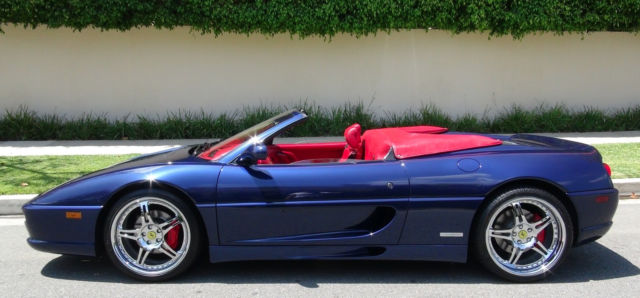

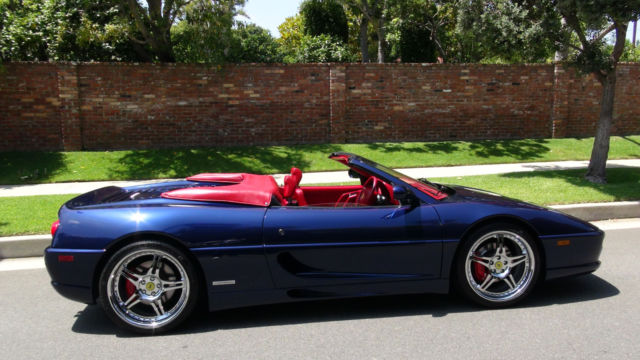
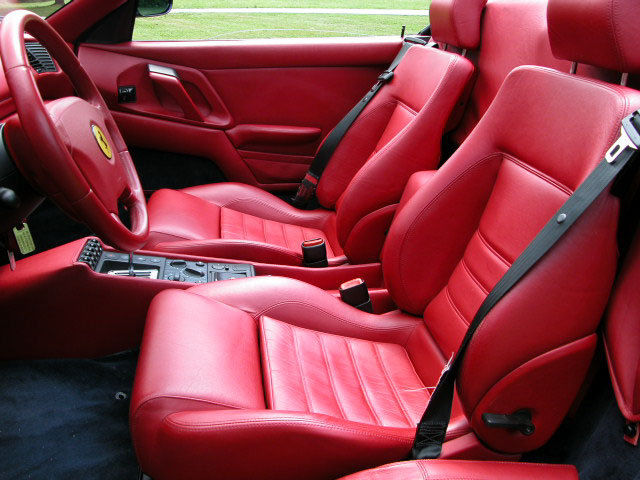
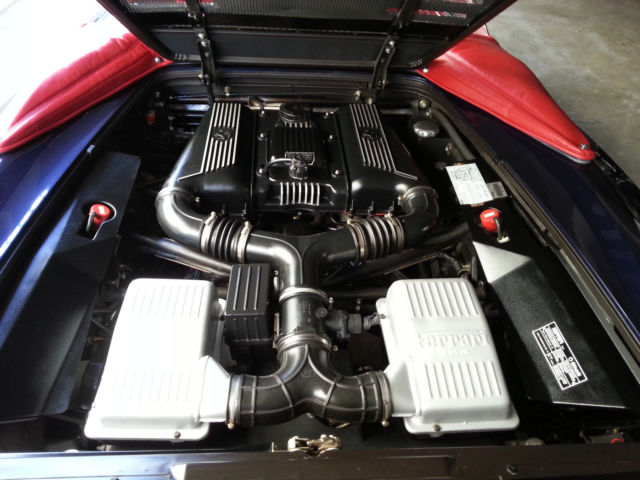
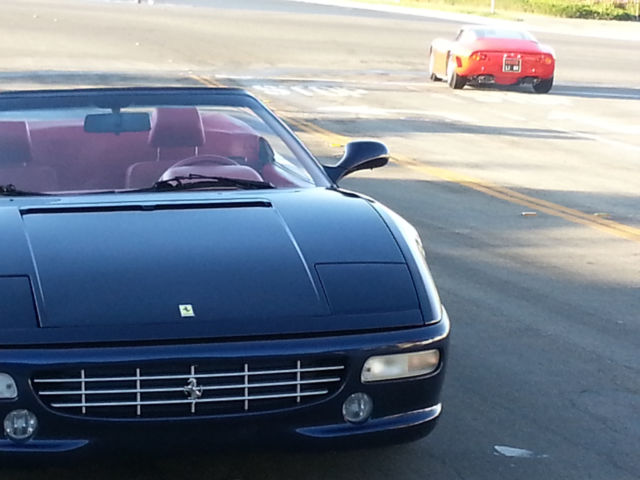
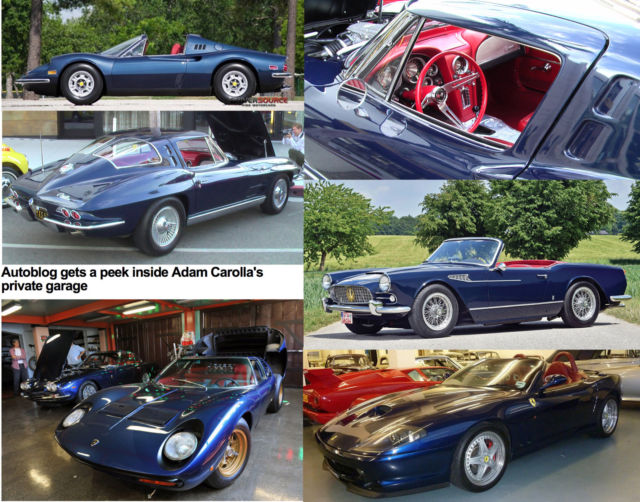
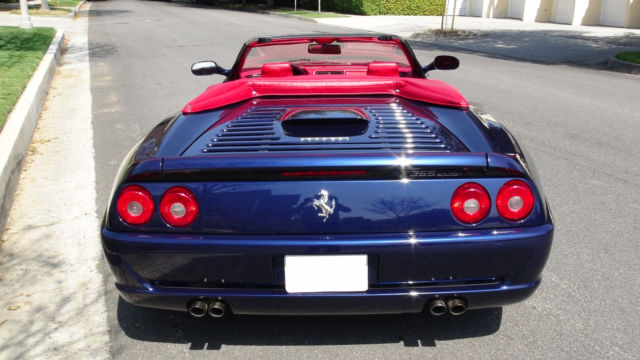
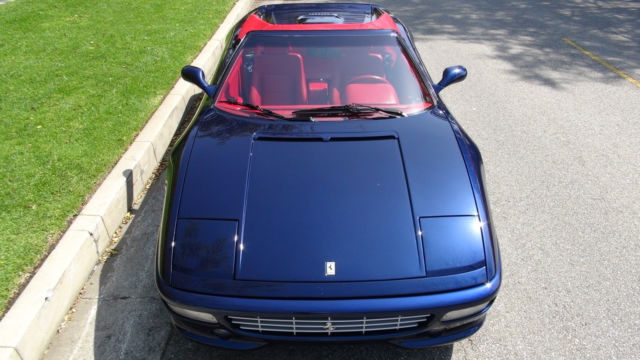
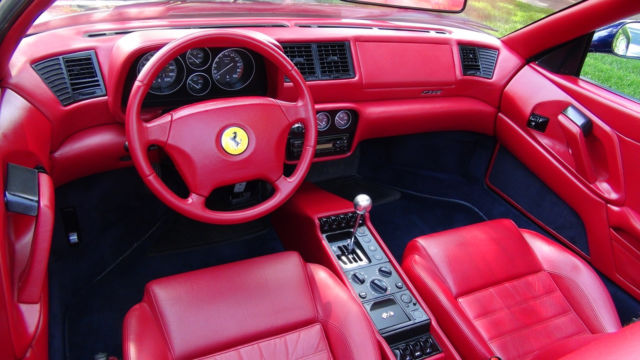
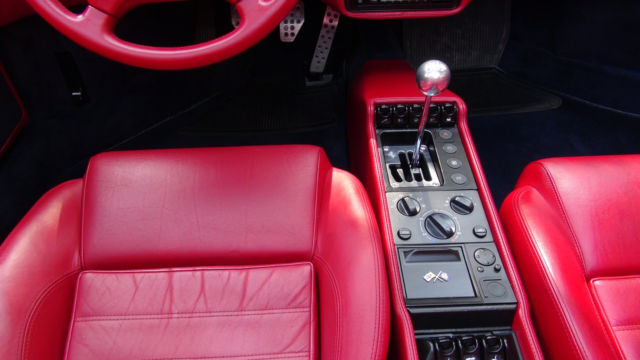
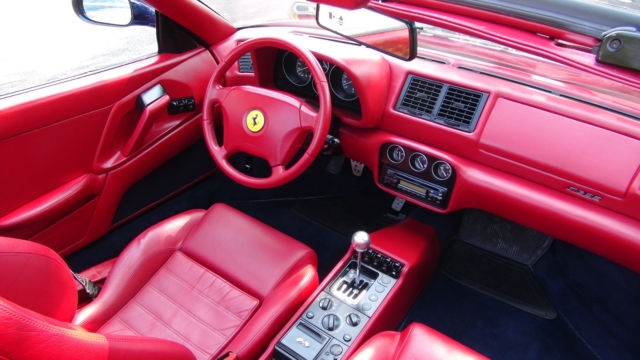
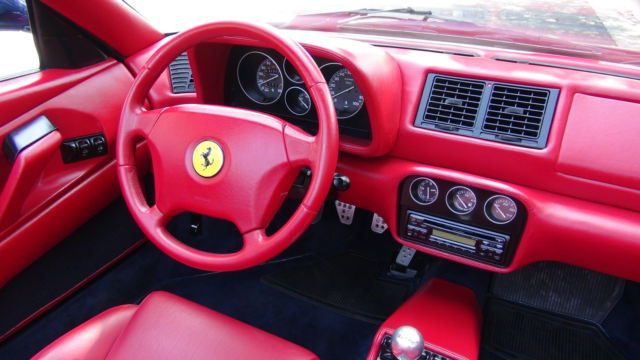
 1995 Ferrari F355 Spider Red/Tan Manual Transmission!! Low Miles! Serviced!!
1995 Ferrari F355 Spider Red/Tan Manual Transmission!! Low Miles! Serviced!!
 1997 Ferrari F355 Spider 6 speed manual. Many upgrades!
1997 Ferrari F355 Spider 6 speed manual. Many upgrades!
 Ferrari F355 SPIDER UNIQUE CLASSIC COLOR 355 SERVICED HRE MANUAL GEARBOX TUBI
Ferrari F355 SPIDER UNIQUE CLASSIC COLOR 355 SERVICED HRE MANUAL GEARBOX TUBI
 1999 Ferrari F355 Spider F1 4K Miles! Best Color Combo! Collection Quality
1999 Ferrari F355 Spider F1 4K Miles! Best Color Combo! Collection Quality
 1999 FERRARI F355 SPIDER F-1 ROSSO CORSA TAN FULLY SERVICED @ FERRARI INCL BELTS
1999 FERRARI F355 SPIDER F-1 ROSSO CORSA TAN FULLY SERVICED @ FERRARI INCL BELTS
 1995 Ferrari F355 Spider, 6-speed manual, 25K miles, fully serviced
1995 Ferrari F355 Spider, 6-speed manual, 25K miles, fully serviced
 1997 Ferrari F355 Spider Manual
1997 Ferrari F355 Spider Manual
 1997 Ferrari F355 Spider Blu Swatters on Blue Scuro 27k miles Serviced 6-SPD!
1997 Ferrari F355 Spider Blu Swatters on Blue Scuro 27k miles Serviced 6-SPD!
 1999 Ferrari F355 Spider, 6-Speed Manual, 14K miles, LATE PRODUCTION, SERVICED!
1999 Ferrari F355 Spider, 6-Speed Manual, 14K miles, LATE PRODUCTION, SERVICED!